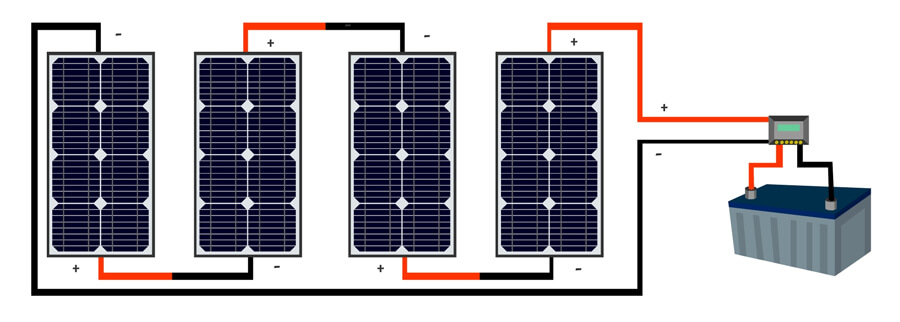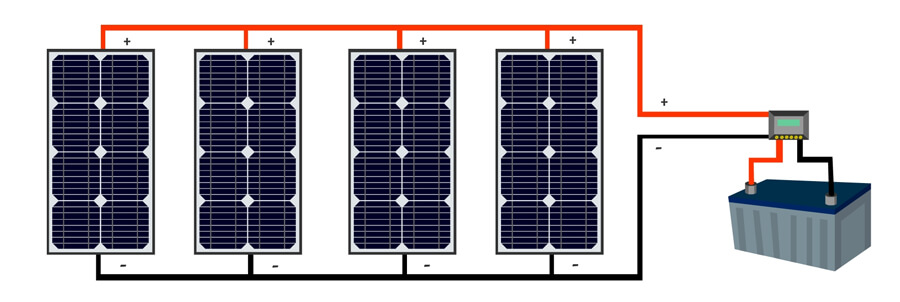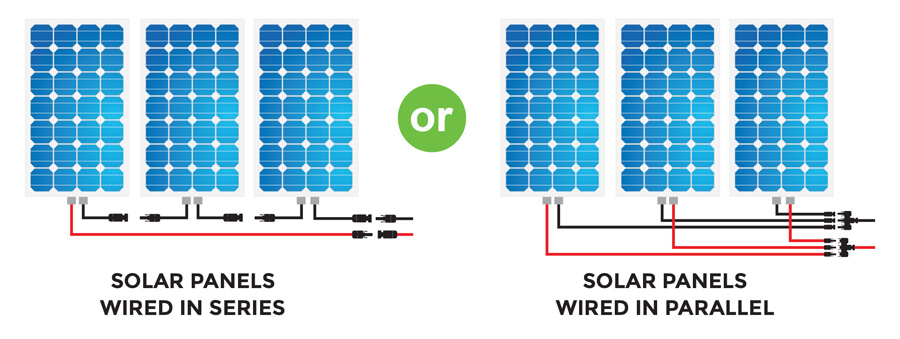Content
When installing a solar power system, deciding whether to connect solar panels serial or parallel is crucial. The choice impacts the overall performance of the solar system, including factors like power output, voltage, current, and efficiency. In this article, we’ll explore the differences, advantages, and scenarios for connecting solar panels serial or parallel.

In a serial connection, solar panels are linked end-to-end. In this arrangement, the positive terminal of one panel connects to the negative terminal of the next, forming a chain. The resulting configuration increases the total system voltage while keeping the current the same as a single panel.
Key Features of Serial Connection:
- Increased Voltage: The total voltage is the sum of each panel’s voltage. For example, if you have three 12V panels, the total system voltage will be $12V + 12V + 12V = 36V$.
- Same Current: The current remains the same as the current rating of a single panel.
- Sensitivity to Shading: A shaded or faulty panel can affect the entire array because the current is consistent across the string.
Advantages of Serial Connection:
- Higher Voltage, Lower Current: Reduces energy losses over long cable runs.
- Easier to Meet Inverter Requirements: Many inverters require higher input voltage, making serial a good choice.
Disadvantages of Serial Connection:
- Partial Shading: Even if one panel is partially shaded, it can reduce the performance of the entire series.
- Higher Voltage Risks: Higher voltage systems can pose greater risks in terms of safety and equipment compatibility.

In a parallel connection, solar panels are connected by linking all positive terminals together and all negative terminals together. This configuration results in an increase in the system’s current while keeping the voltage consistent with a single panel.
Key Features of Parallel Connection:
- Increased Current: The total current is the sum of each panel’s current. If you have three panels each generating 5A, the total current is $5A + 5A + 5A = 15A$.
- Same Voltage: The voltage remains the same as the voltage rating of a single panel.
- Better Performance in Partial Shading: If one panel is shaded, it won't significantly impact the output of other panels.
Advantages of Parallel Connection:
- Consistent Performance in Shading: Panels can continue producing power even if one is shaded.
- Lower Voltage, Increased Safety: A lower voltage system is generally safer to install and maintain.
Disadvantages of Parallel Connection:
- Higher Current, Increased Cable Size: Requires thicker cables to handle increased current, which can raise installation costs.
- Lower Voltage: Might not meet the minimum voltage requirements for some inverters.
Below is a comparative table highlighting the key differences between connecting solar panels serial or parallel:
| Feature |
Serial Connection |
Parallel Connection |
| Voltage |
Increases with each added panel |
Remains the same as a single panel |
| Current |
Remains the same as a single panel |
Increases with each added panel |
| Shading Impact |
High (affects the entire string) |
Low (affects individual panels only) |
| Cable Requirements |
Lower gauge (smaller cables) |
Higher gauge (thicker cables) |
| Safety |
Riskier due to higher voltage |
Safer due to lower voltage |
| Inverter Compatibility |
Easier to match higher voltage needs |
Harder to meet voltage requirements |
How the voltage increases linearly in a serial connection while the current stays the same. In a parallel connection, the current increases with each panel, but the voltage remains constant.

The decision between connecting solar panels serial or parallel depends on several factors, including the desired system voltage, the layout of the solar installation, potential shading concerns, and inverter compatibility. Below are some detailed scenarios that can help guide your choice:
Decision-Making Table: Serial vs. Parallel Connection
The table below highlights different scenarios and recommends the appropriate configuration:
| Scenario |
Recommended Configuration |
Reason |
| Long Distance to Inverter |
Serial |
Higher voltage reduces energy loss over long distances. |
| High Voltage Inverter Requirement |
Serial |
Easier to achieve the voltage needed for the inverter. |
| Limited Installation Space |
Serial |
Fewer cables and simpler setup when space is constrained. |
| Partial Shading Concerns |
Parallel |
Each panel works independently, minimizing shading impact. |
| Safety Concerns (Residential) |
Parallel |
Lower voltage is safer to manage and install. |
| Battery-Based Systems (12V/24V) |
Parallel |
Matches typical battery voltage, increasing compatibility. |
| Hybrid Systems (Combining Serial & Parallel) |
Hybrid |
Balances voltage, current, and system performance. |
When to Choose Serial Connection
-
Long Distance to Inverter: If the solar panels are located far from the inverter, choosing a serial connection can minimize energy losses. A higher voltage and lower current mean less resistance loss, allowing for thinner cables, which are both more affordable and easier to manage.
-
Higher Voltage Inverter: In situations where the inverter requires a higher voltage input (e.g., 150V or more), connecting panels in series can help meet those requirements with fewer panels. This is especially true for off-grid systems with specific battery voltage needs.
-
Limited Space: Serial connections can simplify installations when space is tight. If roof space or available mounting areas are limited, increasing voltage rather than current might make it easier to match your energy needs without using extensive cabling.
When to Choose Parallel Connection
-
Partial Shading Concerns: If shading is an issue in your installation—whether due to trees, chimneys, or nearby structures—a parallel connection minimizes the impact of shading on system performance. Each panel in a parallel setup operates independently, so shading on one panel doesn’t affect others.
-
System Safety: Lower voltage systems are inherently safer, particularly for DIY installations or in residential areas where compliance with safety standards is crucial. A parallel setup keeps the voltage low, reducing the risk of dangerous high-voltage situations.
-
Battery-Based Systems: For systems focusing on charging batteries, particularly 12V or 24V battery banks, parallel connections make sense. Most small-scale battery-based systems prefer parallel configurations to match the typical battery voltage requirements while providing enough current.
In some installations, a hybrid approach—combining both serial and parallel connections—can offer the best of both worlds. This strategy involves creating multiple strings of panels in series and then connecting these strings in parallel. Here’s why a hybrid configuration might be beneficial:
- Balancing Voltage and Current: By adjusting the number of panels in each series string and the number of parallel strings, you can fine-tune the voltage and current to meet specific inverter or battery requirements.
- Improved Fault Tolerance: A hybrid setup can offer better performance under partial shading conditions compared to a purely serial configuration, without sacrificing the benefits of increased voltage.
- Optimized Cable Sizing: It allows for a compromise on cable thickness. You can keep the current at manageable levels without excessively increasing the voltage.
Example of a Hybrid Configuration
Suppose you have 12 solar panels, each rated at 12V and 5A. You could create three strings of four panels each (serial connection for each string), resulting in:
- Voltage per String: $12V \times 4 = 48V$
- Current per String: 5A (remains the same)
By connecting these three strings in parallel, the final system specifications would be:
- Total Voltage: 48V (same across all strings)
- Total Current: $5A \times 3 = 15A$
This configuration balances higher voltage (reducing cable losses) while maintaining flexibility under partial shading conditions.
Inverter Sizing and Compatibility
Regardless of whether you choose a serial, parallel, or hybrid configuration, ensure that the system’s voltage and current are within the acceptable input range of your inverter. Most modern inverters come with MPPT (Maximum Power Point Tracking) technology, which optimizes power output, but it's still crucial to match your panel configuration with the inverter's capabilities. Always consult the inverter’s specification sheet to verify the maximum and minimum input voltage and current limits.
Monitoring and Maintenance
Panel monitoring and maintenance become crucial when panels are connected in different configurations. Here are some tips for each connection type:
- Serial Systems: Consider installing bypass diodes to minimize shading impacts and make it easier to detect any underperforming panels. Micro-inverters, which convert DC to AC at the panel level, can also help improve the output in shaded conditions.
- Parallel Systems: Ensure that the wiring and connectors are rated to handle higher current. Use appropriate fuses or circuit breakers to prevent overloading, especially in large arrays.
- Hybrid Systems: A combination of MPPT charge controllers and micro-inverters can offer the flexibility needed to manage power from hybrid setups efficiently. Regular maintenance checks should include verifying that both voltage and current are consistent across the system.
Cable Sizing and Safety Considerations
Cable sizing is a critical component in any solar installation. The choice between serial and parallel directly influences what cables you should use:
- Serial Configurations: Due to higher voltage and lower current, you can use smaller gauge cables, which are often more affordable. However, proper insulation is necessary to handle the increased voltage safely.
- Parallel Configurations: Require thicker cables to handle the higher current without overheating. Overlooking this aspect can lead to safety hazards, including fire risks and system inefficiency.
Consider installing fuse boxes or disconnect switches to isolate different parts of the system during maintenance or emergencies. These components are especially vital in parallel systems, where high current can be dangerous.
Choosing between solar panels serial or parallel connections requires a clear understanding of your system’s specific needs and conditions. Serial connections are ideal for long-distance installations, higher voltage inverters, and constrained spaces, offering simplicity and reduced energy loss over long cable runs. However, they are more sensitive to shading. On the other hand, parallel connections shine in partially shaded environments, battery-based systems, and when safety is a priority due to lower voltage. The hybrid approach provides flexibility, blending the benefits of both configurations, and is a strong choice for more complex systems. By carefully assessing your situation, you can select the configuration that maximizes efficiency, safety, and reliability for your solar setup.
FAQs








